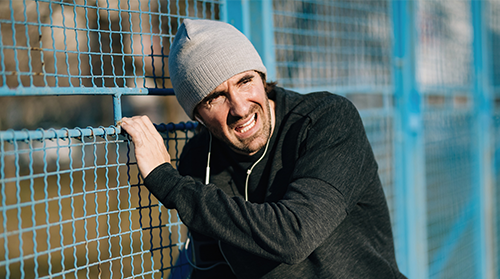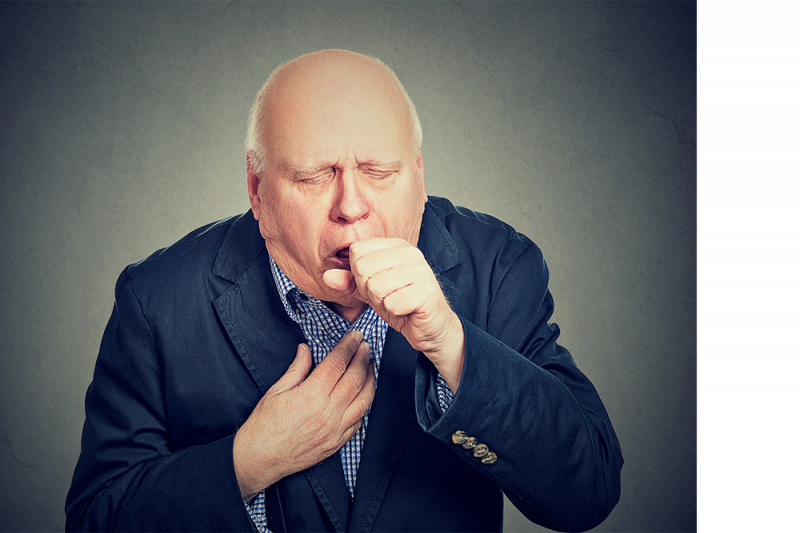
A breathless man in a black hoodie, wearing a grey beanie and white in-ear earphones holds onto a fence for support
What’s it like going through life not being able to breathe properly? For 1 in 20 Australians aged 45 and over, that’s a daily reality.
COPD, or chronic obstructive pulmonary disease, is a term for a group of lung diseases caused by narrowing of the airways and obstructed airflow from the lungs, making it difficult to breathe. It includes long-term lung conditions such as chronic bronchitis, emphysema, and chronic asthma.
When you breathe in, air travels down your windpipe (trachea), through two large tubes (bronchi), into smaller and smaller tubes (bronchioles), that end in grape-like bunches of tiny air sacs (alveoli).
When you breathe out, you are relying on the natural elasticity of the bronchial tubes and alveoli to push the air out of your body. When you have COPD, they lose their elasticity and over-expand, and some air remains trapped in your lungs.
Emphysema and chronic bronchitis are the two most common conditions contributing to COPD, and they may occur together.
Emphysema is where the alveoli at the end of the tiniest lung passages are destroyed by exposure to irritating gases and particles.
Chronic bronchitis is inflammation of the lining of the bronchial tubes that carry air to and from the alveoli. It causes daily coughing and mucus production.
COPD was the fifth leading cause of death in Queensland men and women between 2014 and 2018, and caused more deaths than prostate cancer in men, or breast cancer in women. People with COPD are at greater risk of developing lung cancer, heart disease, colds and flu, pneumonia, and other conditions.
Read on to find out more about causes, symptoms, diagnosis, and treatment.
Causes
COPD is caused by long-term exposure to irritating gases and particles and is most often caused by smoking, but exposure to air pollutants such as gases and dust at home or work can play a role.

Symptoms
The symptoms of COPD are very similar to asthma symptoms, but they usually only appear at an older age (often after the age of 50) and respond differently to medication.
They may gradually get worse over time, especially in ongoing smokers.
They can include:
- feeling breathless
- a new or persistent cough
- producing a lot of phlegm (mucus)
- wheezing and chest tightness
- lack of energy, frequent respiratory infections, oedema (swelling) in the ankles and legs, and weight loss.
Difficulty breathing and being unable to do things that you like while living with a serious illness can also negatively impact a person's mental wellbeing, leading to depression.
People with COPD can experience periods of a few days, known as exacerbations, where the symptoms become worse than their usual day-to-day symptoms.
Diagnosis
Your doctor will ask a range of questions about your medical history, particularly if you smoke, have smoked or have allergies. You may also be asked about your work environment.
They will listen to your chest and examine you, and use a test called spirometry. A spirometer measures how much and how quickly you exhale. It can help indicate of how severe the COPD is. Chest x-rays or scans and other tests, such as arterial blood gas tests, may also be needed.

Treatment
There is no cure for COPD, but it can be managed, and treatment can ease symptoms, slow progression, and prevent complications.
If you smoke, the number one thing is to quit smoking. Help is available and many Queenslanders successfully quit every day. Talk to your doctor, call Quitline (13 78 48), or request a Quitline call.
It’s also important to avoid smoke and other air pollutants at home and work.
Medication may relieve symptoms such as shortness of breath and help reduce the risk of exacerbations. Home oxygen therapy may be required if blood oxygen levels are too low.
A personalised treatment program or management plan can help people with COPD manage their symptoms and improve their quality of life by learning to breathe better, conserve energy and have appropriate food and exercise programs.
The most effective treatment for breathlessness is to improve fitness levels.
Pulmonary rehabilitation programs include exercise programs to help improve fitness and learn about breathing techniques, medications, and other ways to help breathing.
Pulmonary rehabilitation can also reduce symptoms of COPD and reduce the risk of exacerbations and hospital admissions.
Vaccination
It’s important people with COPD are vaccinated against influenza and COVID-19. Some people may benefit from other vaccinations as well. Your doctor can recommend what vaccinations would help.